Rugs are a hot category for furniture retailers and getting hotter. That's because area rugs add color and excitement to furniture store displays, present an opportunity for add-on sales using little or no extra floor space, and allow furniture retailers to present, along with other accessory items, a complete room package.
Area rugs add design pizazz to your customer’s rooms, create visual and physical warmth, and can inject a great pop of color or pattern. More than any other design element, rugs help to define seating and dining areas. They can also be used to break up large spaces to create visual order in what might otherwise be a chaotic scene.
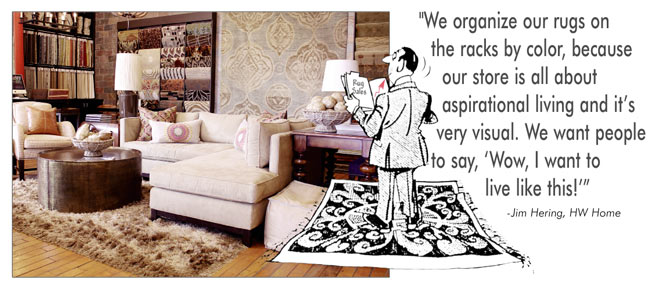 HW Home's flagship Cherry Creek North store in Denver shows rugs in vignettes, hung on walls and in waterfall type displays (above) .
HW Home's flagship Cherry Creek North store in Denver shows rugs in vignettes, hung on walls and in waterfall type displays (above) .
Rugs add comfort by softening hard surfaces. They absorb and reduce ambient noise, and when used with the proper padding, provide a non-slip surface for floors and stairs.
The category offers lots of upside potential for retailers who buy, present and sell rugs skillfully. Challenges are present as well since furniture stores face increasingly aggressive competition from other channels of distribution including mass merchants and online retailers.
Furniture World asked experts in the field of rug sales to offer suggestions regarding best practices for selling rugs in furniture store environments. In this issue we look at best rug sales practices with an emphasis on display and on how to create a compelling buying experience for customers. The November/December edition will focus on retail sales training programs, and sales techniques.
Channel Evolution
“Rugs are a really fast growing category,” notes Asha Chaudhary, President of Jaipur Rugs. She told Furniture World that the rug business is doing well for several reasons. “Distribution has expanded to include many different types of retailers, ranging from furniture stores with standard displays to beautiful home décor boutiques that curate product selection to their own needs. Obviously, the online segment has grown as well. I don’t think six or seven years ago any of us could have known that people would buy so many rugs online. This trend has continued and it’s still evolving. Retailers that understand the category and commit to it can do extremely well and make really good margins. Rugs are an accessory item that play a big role in completing the look of the home."
"There is such a mix in the rug business,” adds Allen Robertson, VP Sales for Capel Rugs. "You have furniture stores, and gift/ accessory stores now in the rug business, and a lot of other types of distribution as well. It’s a mixed bag. The flooring stores and carpet stores kind of phased out of the business for a while, but it seems that they are looking back at it again.”
We asked about elements that must be in place for a furniture store to sell a lot of rugs. The first mentioned was commitment.
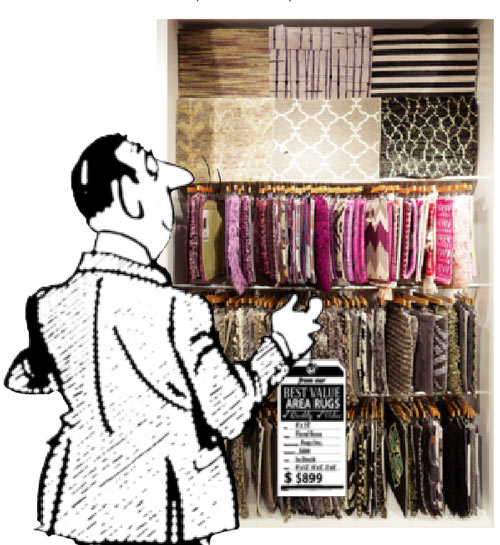 Image of swatch display shown above, compliments of Surya.
Image of swatch display shown above, compliments of Surya.
How To Do Well
Seth King, Surya's Vice President Sales told us, "When dealers ask, ‘What can you do to help me sell accessories?’ I say, ‘We have a pretty good plan to get things implemented, but ultimately the only way it’s going to work is if you, the owner, gets involved.’ First, owners have to push sales managers to sell the product, and sales managers need to push their sales people. The second important factor is to measure sales per associate. If you don’t measure, how can you hold anybody accountable? Rugs and accessories become an after thought unless stores focus their full attention monthly, weekly and daily. They need to do it the same way they track their furniture sales, protection sales, and mattress sales.
“Over a couple years,” King continues, “we’ve seen retailers take their accessories business from zero dollars, or nominal dollars, and make it into a viable category. In general, the worst guys are selling accessories at a one, two percent clip, so it’s really meaningless to them. The best stores are in the 15 percent range, maybe 20 on the high side. An average furniture store can really aim to get that to seven, eight percent, and they should. Stores can create revenue where there wasn’t revenue before. Another way of thinking about this is that without a strong rug program, they basically have revenue walking out the door.”
Likewise, Jaipur's Asha Chaudhary has seen the transformative nature of commitment to the rug category. "What I’ve noticed that differentiates the best furniture retailers," she says, "is they have a huge assortment of product and they adopt a company-wide attitude that gives importance to rugs. It’s not the last category that comes to their minds. Stores that start with a mindset like this are generally a lot more successful. It helps them to stay focused on the price points where they can successfully compete, places where they can differentiate, and how they should merchandize the rugs on their floors.”
“Regarding measurement,” she says, “We have a retail customer that measures turns by each arm rack. They go through those racks every three to six months and identify rugs that don’t turn and replace them. In this regard they treat rugs like any other product category. Retailers should go into as much detail as they can. They might even plan how rugs are displayed to fine-tune the percentage of rugs carried by price point and by style category, traditional, transitional and contemporary. There are some retailers that do a good job in this regard, but most don’t go into that degree of detail.”
The Furniture Store Advantage
Transitioning to a discussion of how furniture stores can leverage their unique assets to sell rugs, Surya's Seth King suggests, "The advantage furniture stores have versus online, or versus a retailer such as Home Depot is simple. It’s the service and design expertise of the sales person. When a customer walks in and is greeted by an old-school salesman in that old suit, who wants to push a sofa, knows all the specs, but has no clue about the importance of design, the sale will likely be lost because that customer is not going to have confidence. But if they are greeted by someone who lives and breathes design, gets passionate about it, is interested in putting a full package together for them, and makes sure to add on pillows, rugs and throws to make their room look great, that’s what really wows customers.
“There’s no way for customers to coordinate what’s in their living rooms with what they see online. Stores have a huge advantage. It’s true that consumers can often find a better price online, but there is a downside. There are a million and one rugs and a million and one pillows, and a million and one everything else online but it’s pretty hard to curate that selection."
From Safavieh’s Glen Cove New York store showing rugs showing a prominent rug gallery (below)
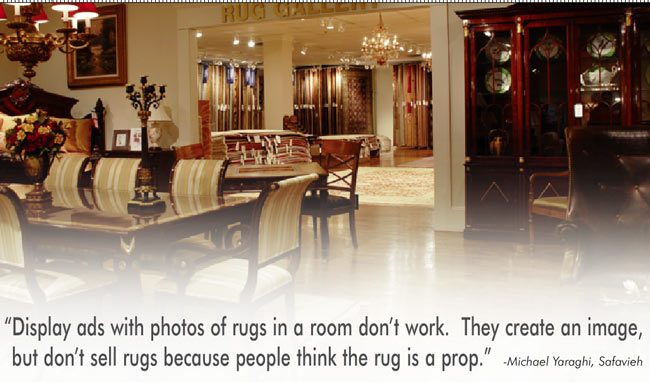
"A consumer in Home Depot,” confirms Jaipur's Asha Chaudhary, has to try to figure out how to match a rug and pillows they see with their sofa. Retailers, especially small retailers, as they compete with stores like Home Depot and online merchants, need to discover how to make their services a bit more personalized, their selection more curated, and the buying process a little bit easier.
“Every store needs a point of view. Furniture retailers have an opportunity to package furniture, rugs and accessories to make buying easy for customers. Buyers need to understand their stores, and seek out looks that will differentiate them from other competitors. In that sense it’s like buying any category of furnishings. Rugs have become much more of a fashionable category, and especially smaller furniture stores can successfully differentiate their displays with rugs because they follow current trends, and add a lot of style through the use of colors and patterns.
"Today everybody’s trying to do such a brilliant job," concludes Chaudhary. "That makes it difficult for a small retailer to differentiate itself without having that point of view. But once they figure it out, it becomes very easy to merchandize around that idea to create an experience that feels special for customers."
Display
Part of committing to the category is letting shoppers know that you focus on selling rugs. Display is critical.
Rugs can be integrated into vignettes, shown in piles, racks and on walls.
Although racks are an important part of just about any furniture stores' program, all of the interviewees stressed the importance of showing rugs in vignettes.
“In our concept,” says Michael Yaraghi, president of Safavieh Home Furnishings a chain of stores in New York, New Jersey and Connecticut, “we find it increases sales when rugs are merchandised in every furniture vignette possible. Rugs help warm up the display and make the furniture more inviting. It also helps to fully coordinate with pillows and accessories. Furniture displayed without a rug is very cold.”
Joyce Lowe, Executive Director of Nourison's Area Rug Division stresses that retailers should, "Utilize vignettes or small room settings to allow the customer to see a rug in an authentic environment. Furniture stores especially can utilize this method to encourage customers to purchase a total concept, rather than a separate accessory."
Rugs have a distinct graphic element to them that can update and add interest to retail displays. Photo credit: Jaipur.
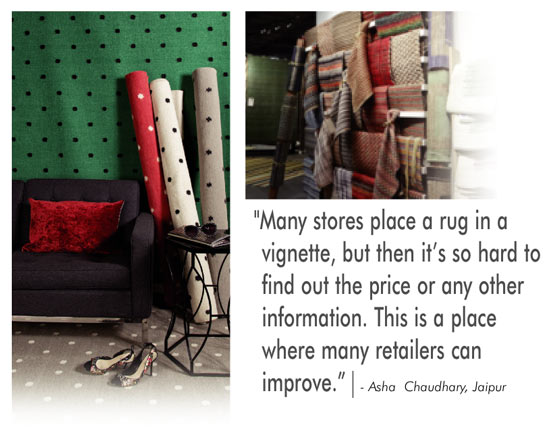
Merchandising and display play a huge role, agrees Jaipur’s Asha Chaudhary. For instance, furniture stores tend to be most successful when they show rugs in as many vignettes as possible, not just in one or two areas. They support these displays with either a rug rack or, another display solution.”
create a successful
Rug Buying Experience
Rugs can be used to create excitement, add color and help customers to create beautiful, comfortable, functional rooms. So why do some stores, as was mentioned earlier, do just a few percent of their volume in rug sales and others do much better?
It’s because the best ones do more than put a rack in the back and scatter rugs in vignettes. Retailers that have a commitment to rugs tend to focus on the sales process and how rugs contribute to a total store experience.
“When you talk to many furniture store owners about the category,” explains Surya’s Seth King, “the number one thing they say is, ‘Oh, I can’t sell accessories.’ They’ve tried and they’ve failed in the past, but that doesn’t mean that if they had the right process, they couldn’t be successful. So, I ask them to consider companies like Pottery Barn and Crate and Barrel. Those are the guys who have figured out how to sell accessories. Their showrooms are merchandised beautifully. There’s a consistent theme. They figured out that to be really successful, they can’t just sell a sofa and a dining room table. They need to sell the look and feel, the full vibe. And that’s what some of our guys are starting to see, understand and actually try to transition into.
“Displaying rugs in vignettes is most important, because it ties rugs to the furniture. That’s where customers shop. And the better stores are leaning towards providing a stepped up experience, a designer kind of experience," continues King. “These stores are starting to realize they need to sell the full concept, including the rug, end table, lighting."
A store that has done a great job selling rugs by delivering a well thought-out experience is HW Home. Jim Hering, Vice-President & Co Founder of the three-store, Colorado-based operation, related that his stores average about 8000 square feet each. "Every square foot is extremely valuable and we don’t have the space to set up rug displays like some of these like behemoths in the industry do,” says Hering.
"Rugs were a low priority for us at the beginning. We showed some wool rugs stacked in a corner. But as our business has grown over the course of the past 16 years, we realized that there had to be another way, and so we set up a display wall with a racking system that’s a little bit unique, with rug samples hung so that they look like a kind of a water of color. It takes up no space whatsoever, except for occupying one large wall. We also display some folded rugs in front of it. It costs a little bit of money to make that display happen, and for it to look right, but it really gives shoppers the idea that we are in the rug business, and that we do sell rugs.
"Rather than using big display racks that show 9x10 or 9x12 rugs, we took a different approach showing folded or rolled rugs in a pile and rugs displayed throughout the store in vignettes. We added a racking system that displays rugs, approximately 2x3 feet in size, hung on a very interesting display system. Shoppers can actually see how the rugs will appear in their homes, and then use the display racking system with the smaller rug size.
"If someone has a question about what the exact pattern looks like, it’s very simple then to go online or refer to the catalog and say, “Okay this is what it looks like in the full eight by ten size.” We use the small sample, to show them exactly what the color looks like. It’s a system that works extremely well because it doesn’t take up a whole lot of space in the store, and we are able to hang literally hundreds of samples.”
Summing up the challenge of having limited space available in some stores, Cyrus Loloi, Principal at Loloi Rugs adds that, “Retailers who are limited in terms of available space may consider displaying small rugs in different ways. There is a lot of flexibility for displaying smaller rugs in groups up against a wall in a waterfall-type display. It takes up wall space, but very limited square footage. Even if display space isn’t limited, we’ve found that investing in great lighting for the rack area helps rugs show and sell much better. Paying attention to details such as having plenty of rug clips at the top of rack displays helps them hang better without buckling.
Tagging & Signage
"Regarding placement of a rug department," muses Capel's Allen Robertson, "we’d ideally like to be on the first level in a multilevel store, as close to the front as we can get. But usually rugs end up in the back. So, since most customers are going to be looking initially for furniture, a key thing stores need to do is make sure they have in-store graphics that show the rugs in a lifestyle setting. And, my opinion is that it should be placed somewhere close to the front of the store to create interest so that consumers know to look for the rug department. This signage should be more permanent than on an easel that may easily get knocked over. The rug area should also be clearly identified with some type of signage that says this is the way to go to buy rugs."
Nourison's Joyce Lowe agrees, observing that, "eye catching, informative and versatile Point of Purchase display materials such as full color posters and brochures should be utilized as often as possible. They offer the ability to generate interest without creating large, floor consuming displays.”
In vignettes as well, notes Jaipur’s Asha Chaudhary, "signage plays a huge role. The best stores make it easy for their customers to shop. Many stores place a rug in a vignette, but then it’s so hard to find out the price or any other information about that rug. This is a place where many retailers can improve. Good signage makes rugs more visible, easier for customers to get sizes, prices and to make up their minds.”
"Some retailers don’t merchandise rugs with all the proper tagging in a vignette," adds Seth King. Customers may not even know the rugs are for sale. It’s important to have a tag on it that says, ‘This rug is for sale at 300 bucks,’ or whatever the cost is, then include all of the size options that go with that rug.”
Concludes Cyrus Loloi, "It’s so important to have proper tags with all the information easily accessible to customers. Again, this seems commonplace but we see a lot of retailers that don’t do this well."
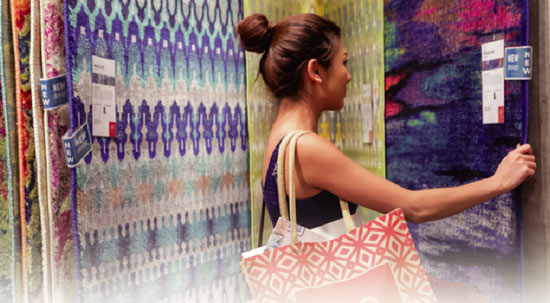 Rugs on racks should be properly tagged, and organized to help customers choose. Photo from Loloi.
Rugs on racks should be properly tagged, and organized to help customers choose. Photo from Loloi.
More Best Practice Quotes & Ideas
Encourage Impulse Buying/ Reorder Immediately. "For display, rug racks are still the best way to go. Large chains often hang rugs and do special order business. But, people do look at rugs and want to buy ‘em instantly. So, for smaller stores especially it’s a good practice to encourage impulse buys by letting shoppers take rugs with them. Which brings us to a second item which is that these stores need to have a process in place to reorder immediately. This is something that lots of retailers just don’t do well.
-Allen Robertson, Capel
Advertise Rugs Separately: “We find catalogs mailed to our customer list work best. And the best way to advertise rugs is to feature them in a separate section of the catalog designated to area rugs. Display ads with photos of rugs in a room don’t work. They create an image, but don’t sell rugs because people think the rug is a prop. The best time to advertise is the cooler seasons, fall, winter and spring when people are indoors. Summer is not a good time to advertise rugs – except for outdoor rugs.”
-Michael Yaraghi, Safavieh Home Furnishings
Update Store Displays With Rugs: “Rugs are a really great category retailers use to distinguish the look of a store, because they have a distinct graphic element to them. You may be showing the same brown sofa, but by just changing two pillows and the rug, you can create an updated, fresh feel.
-Asha Chaudhary, Jaipur Rugs
Light Rugs Properly: “Paying attention to the position of lighting fixtures is important. Poor lighting can alter colors and lead to increased returns. Fluorescent lighting tends to give rug colors a washed-out appearance. Incandescent halogen spotlights are recommended to help customers see the true colors of the rugs.”
-Joyce Lowe, Nourison
Where To Place Racks: “Every store approaches placement differently. Obviously, putting a rack in the back of the store, neglected with poor lighting, it’s not going to do as well. If it were up to me, I would put the display somewhere close to the front, with prominent lighting to help show it off the best.”
-Cyrus Loloi, Loloi Rugs
Catalogs Are Valueable Sales Tools: “Among the most valuable sales tools are catalogs. Catalogs provide a complete look at every design in every available collection. They offer retailers the ability to show each rug even if there isn’t room to display them all.”
-Joyce Lowe, Nourison
Promotions That Bring In Traffic: “For us the promotion that really brings in traffic is cross merchandising. We offer a discount on a rug when we sell a dining room; and a discount on the dining room when the customer buys a rug. We always make the rug an add-on in the sale.”
-Michael Yaraghi, Safavieh Home Furnishings
Up Selling The High End Customer: “We up-sell by introducing customers to designer’s rugs. High-end consumers love licensed branded rugs by top designers. We also introduce certain customers to antique rugs to up the sale. We explain how they are investment pieces, true art and many in our collection are one of a kind. People appreciate the beauty and character of antiques.”
-Michael Yaraghi, Safavieh Home Furnishings
Remember That Customers Are Impatient When Choosing Vendors: "Remember that people don’t like waiting for rugs. So if we need to tell a customer they have to wait six months for a rug, we’re not going to get the sale. But if somebody finds out they can buy it and it’s in stock, and they can have it in less than two weeks, we can close the sale that second.”
–Jim Hering, HW Home
Choose Suppliers That Make Life Easy: "I look for rug lines that make it easy to choose products, which means having an excellent online presence. For example, I was on a supplier’s website for an hour and a half this morning shopping, trying to find the perfect rugs for every single room (in a project for a client). And I was able to do it, very easily and simply because not only was I able to see what the patterns look like and get the exact Pantone coloration number, but also get stock availability and pricing. That kind of interface makes designing, shopping and retailing, so easy that it’s almost difficult to envision going to anyone else."
-Jim Hering, HW Home
Turn Over Slow Moving SKU's: “Don’t let a rug sit in inventory too long. Get rid of it, give it away, or give some great deal on a rug that goes with that sofa a customer just purchased. Find a way to blow it out.“
–Seth King, Surya
Consider Creating A Separate Rug Gallery: “A best practice for furniture stores is to have a separate rug gallery. Rugs should be displayed on racks by color or quality or style, traditional, contemporary or casual. Some of the worst errors are not to have a rug gallery, not train sales people, and not to display rugs in furniture vignettes.”
-Michael Yaraghi, Safavieh Home Furnishings
Flipping Rugs In Piles: “I’ve never liked seeing piles of rugs in furniture stores. Unless a retailer has people available to constantly flip them, it’s not ideal. A second drawback is that many consumers just want to take their time. Rugs are heavy. If I were a customer and two people were helping me flip through rugs, I might feel pressured to make a purchase. Showing rugs in racks and in vignettes provide a much better experience than displaying them in piles.”
-Asha Chaudhary, Jaipur Rugs
Sell The Package: “Furniture stores are well suited for the total concept approach to selling. Why sell a sofa or a chair when you can sell an entire room. Today more than ever, area rugs are being purchased as a part of a room rather than an accessory to it. The total concept approach offers a number of benefits to both the consumer and the retailer, the greatest of which is increased customer satisfaction and increased revenue. An added benefit for furniture stores is the minimum amount of space it takes to display area rugs. By using the tried and true Swing Arm display method furniture stores can show up to 60 area rugs in the space it would normally take to display one living room. In other words, in the space it would take to sell one living room, dozens of area rugs that complement one or more sectionals, sofas, or dining from suits shown in vignettes across the showroom floor can be easily accessed.”
-Joyce, Lowe, Nourison
Below, rugs displayed in a creative design area can focus attention on the importance of rugs in the composition of a beautiful room. Photo credit: Capel Rugs.
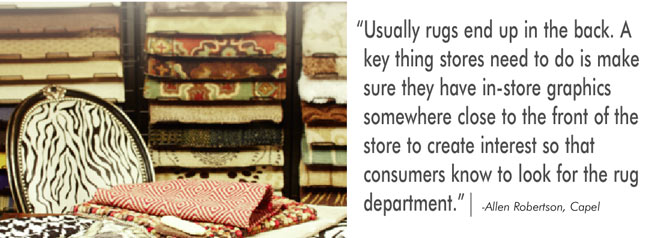
Product Training Sessions - “Product training sessions can be a powerful tool in the struggle to achieve superior product knowledge. Held at least twice a year, they serve to keep everyone up-to-date on changes and new product offerings, additional promotional opportunities available and emerging trends in the marketplace.”
-Joyce, Lowe, Nourison
Transform Displays: “For the customer, rugs and pillows can transform a beige room, to whatever she wants. Plus changing rugs and accessories every six months help keep displays fresh and encourages customers to come back to see something different. If you switch out a beige sofa or a brown sofa — who cares if the arms are different? It still looks the same to the consumer. But if purple is a hot color, adding in colorful rugs and purple pillows is a great way to update what you have to offer.”
-Seth King, Surya
Follow up Cards & Promos: Use rugs as a way to get customers back into the store. Follow up on the sale of dining room or living room furniture with a personalized offer on select rugs at a discounted price.
House Calls: If your store has a house call program, think about bringing some rugs along for the ride to give customers an idea of how they will look in their homes. Close rates on house calls can be 85 percent or higher.
Next issue
In the next installment of this rug sales education guide we will explore best practices for selling rugs, from training to the close and beyond. See it at...
https://www.furninfo.com/Series/RugSales
Russell Bienenstock is Editor-in-Chief of Furniture World Magazine, founded 1870. Comments can be directed to him at editor@furninfo.com.